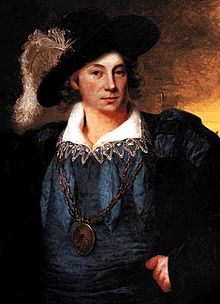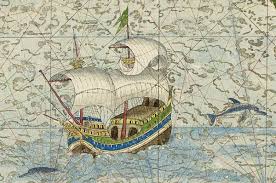In honor of Earth Day and the March for Science, we’re going
to take a look at science in the early 1700’s. With an emphasis on pirates, of
course.
This was the time period called “The Enlightenment.” After
the Dark Ages, centuries when Europeans barely kept hold of the knowledge of
ancient times, let alone created new knowledge or understanding of the world
around them,
Some place the beginning of the enlightenment as late as
1715, others as early as 1620. It was based on the Science played an important
role in Enlightenment discourse and thought. Many Enlightenment writers and
thinkers had backgrounds in the sciences. They associated scientific
advancement with the overthrow of religion and traditional authority in favor
of the development of free speech and thought.
In many ways, this was a result of the printing press,
greater literacy (at least among the wealthy) and a wider spread of knowledge.
When human understanding of the world’s workings were confined to small enclaves,
largely controlled by religious institutions, the words of old philosophers can
be handed down as immutable fact. When many people can read, and communicate
their ideas with each other, people can begin to question things that don’t line
up with their observations.
For centuries, Aristotle and the Bible had agreed that Earth
was the center of the universe. Galileo Galilei
observed the motion of the moon (as revealed by tides), the phases of Venus,
and the orbit of Jupiter’s moon, and determined that Earth orbits the Sun. This
was a radical notion, and it got Galileo in a great deal of trouble. The old
ways do not die easy.
(And a note, here. Neither pirates nor anyone else believed
that the earth was flat. The ancient Greeks had proved its spherical shape, and
had measured its diameter to a highly accurate degree. Sailors saw regularly
that, as their ships traveled, land seemed to rise and sink from the ocean. Stories
of monsters and falling off the edge were drunken bravado and tales for
land-lubbers.)
However, as the dates in the third paragraph indicate, the
Golden Age of Piracy falls in the beginning of this age of Reason. While the
idea of “science” was catching on, it was still largely the thought-playground
of the rich.
Take medicine. Our pirate friends, along with everyone else
from Europe, still believed that disease was caused by “bad air” or “bad water.”
Even the idea sickness could be transmitted directly from one human to another
was radical. Germ theory was over a hundred years off. Even the idea that dirt
causes sickness was not established.
Because of this, the most common form of treatment for
sickness was trying to bring the “humors of the body” into balance. This was
most often done by bleeding, or by giving the patient herbs or drugs that
caused intense vomiting or diarrhea. The fact that a sudden loss of blood can
end a fever, or temporarily treat high blood pressure, and violent intestinal
spasms can drive out parasites, only muddied the issue.
Cleanliness was regarded with suspicion. The Protestant
Churches (official religions of England and the Netherlands) discouraged
washing as “worldly”. Most people lived in filth that would be difficult for a
modern person to believe. In addition to not washing, they drank water straight
from lakes and rivers, even if those contained raw sewage and decomposing animals.
Today, we can credit science with not only with understanding
that germs are dangerous, and teaching us how to kill them, but with
discovering other dangers in life. The 18th century was awash with
alcohol – children drank liquor as soon as they were weaned. Mothers drank throughout
pregnancy.
And of the other dangers, the most prevalent was lead. Today
science has taught us that lead is a dangerous substance. Ingesting it can be
deadly, and even touching it with bare skin can damage the brain. In the 18th
century, the world was awash in lead. Lead water pipes, lead-based paint, lead
based makeup. Sheets of lead were a common material, used for a variety of
things. Pirates wrapped scraps of sheet lead around the flints in their guns,
to better fit them into the screw-hold of the hammer. Every time I think of the
lead being handled by common pirates and sailors, I wonder how many IQ points
it cost them.
Anything resembling the practice of birth control was believed
to be a sin against God. Women in Europe gave birth to a dozen or more children
in their lives. This was necessary, however, since as many as a third of
infants did not make it to their second year. The women, worn out by
childbearing, died young. Today, women outnumber men. In the 18th
century, there was a shortage of older women.
 |
| A pistol flint with its base wrapped in lead |
Capitalism was in its infancy. The old system of medieval
feudalism had broken down. Land was increasingly held by a small number of the
rich. Under the old feudal system, everyone was entitled to work, a home and a
place in society. But as new lands were explored (This era is also called the
Age of Exploration) and new products came to market, the rich wanted cash.
In the new spirit of understanding the world as a mechanism,
understandable to the human mind, the owners of “capital” saw human labor as if
people were machines. Employees were work-producing units, and employers had no
more responsibility to the workers they employed than to the animals they
owned, or the carts pulled by those animals.
So, while the place of the educated man was seen as being semi-divine,
capable of grasping the very workings of the universe, the working class, the
uneducated, were viewed as little more than animals.

This was what the pirates were fighting. In a changing
world, the place of the working class was being pushed down, money was becoming
more important, and human rights were failing, pirates struck out against the
immediate cause of their oppression. Their leadership may have heard the
stirrings of change… Humans were not locked into their place in the economic ladder.
God had not ordained what a man did with his life. The pirates chose to stand
up, and try to change the world.



















